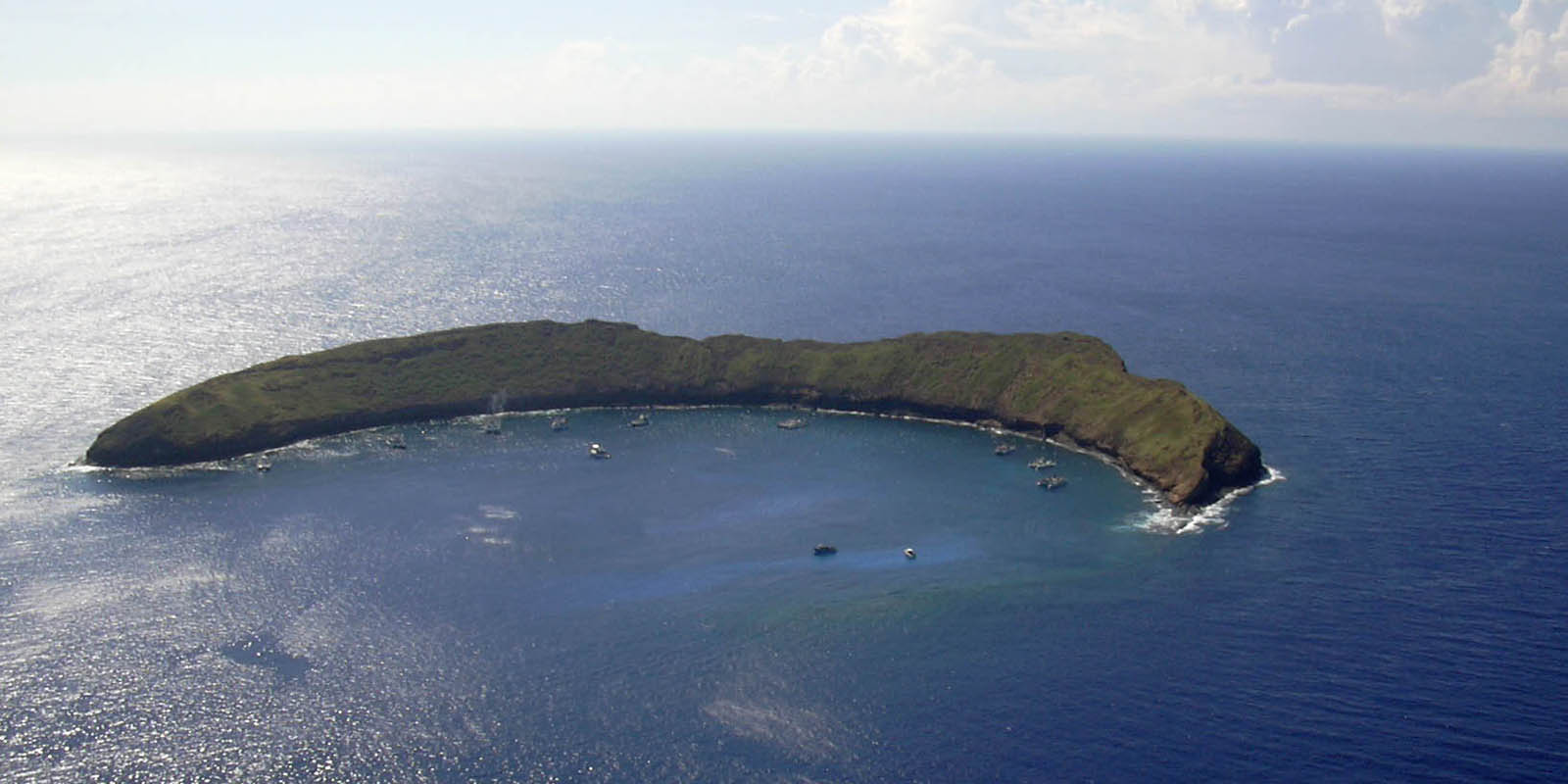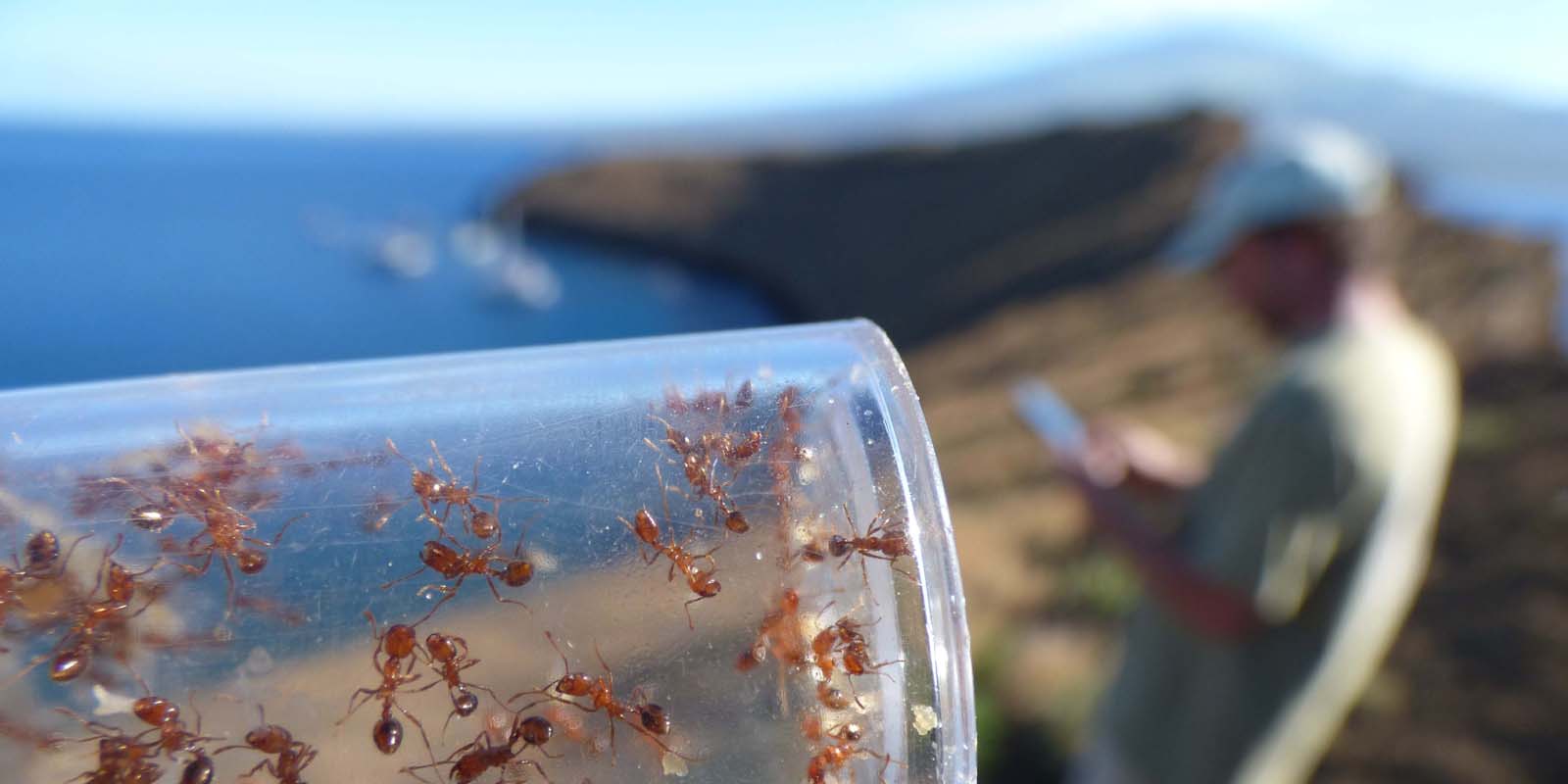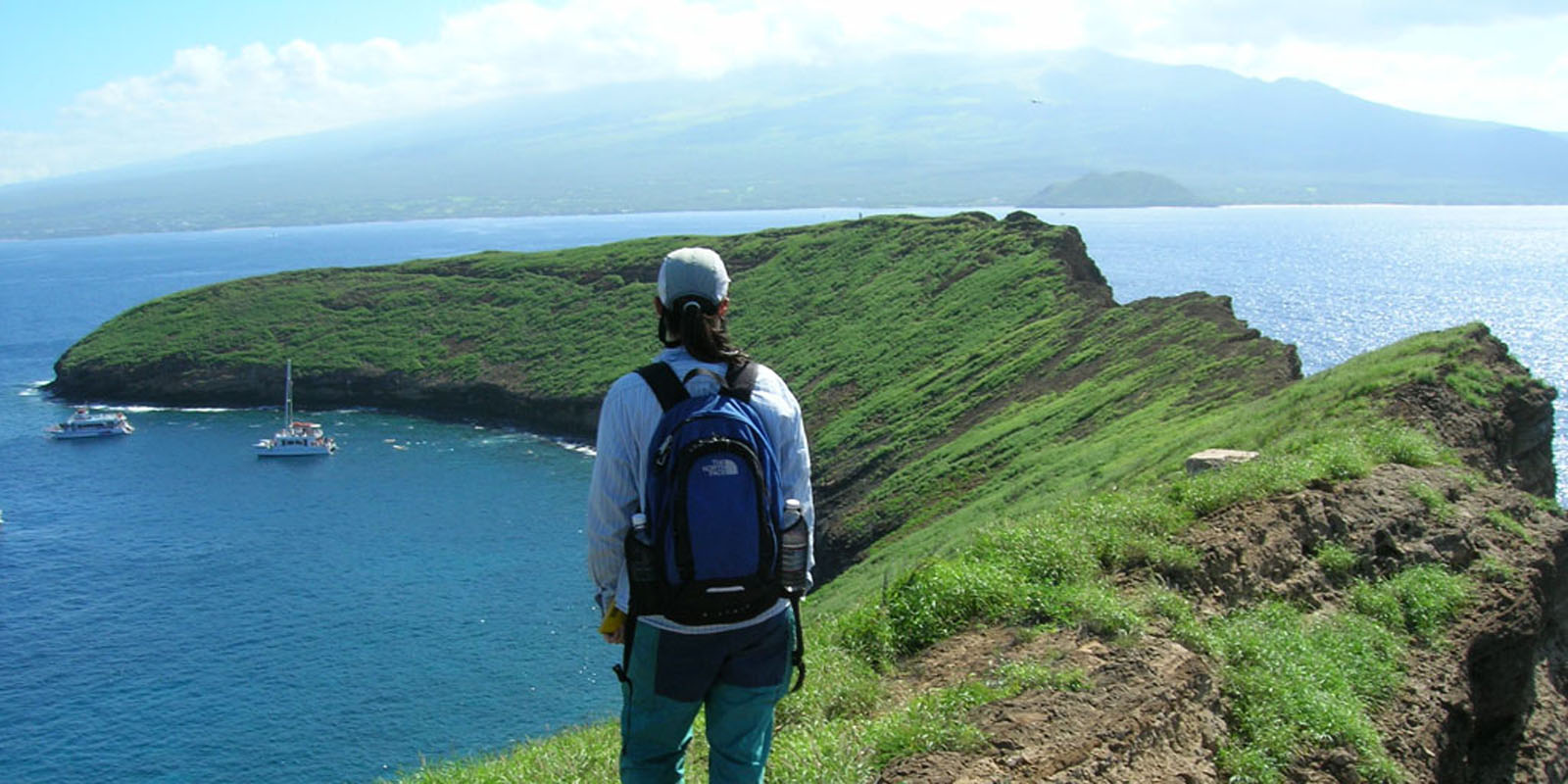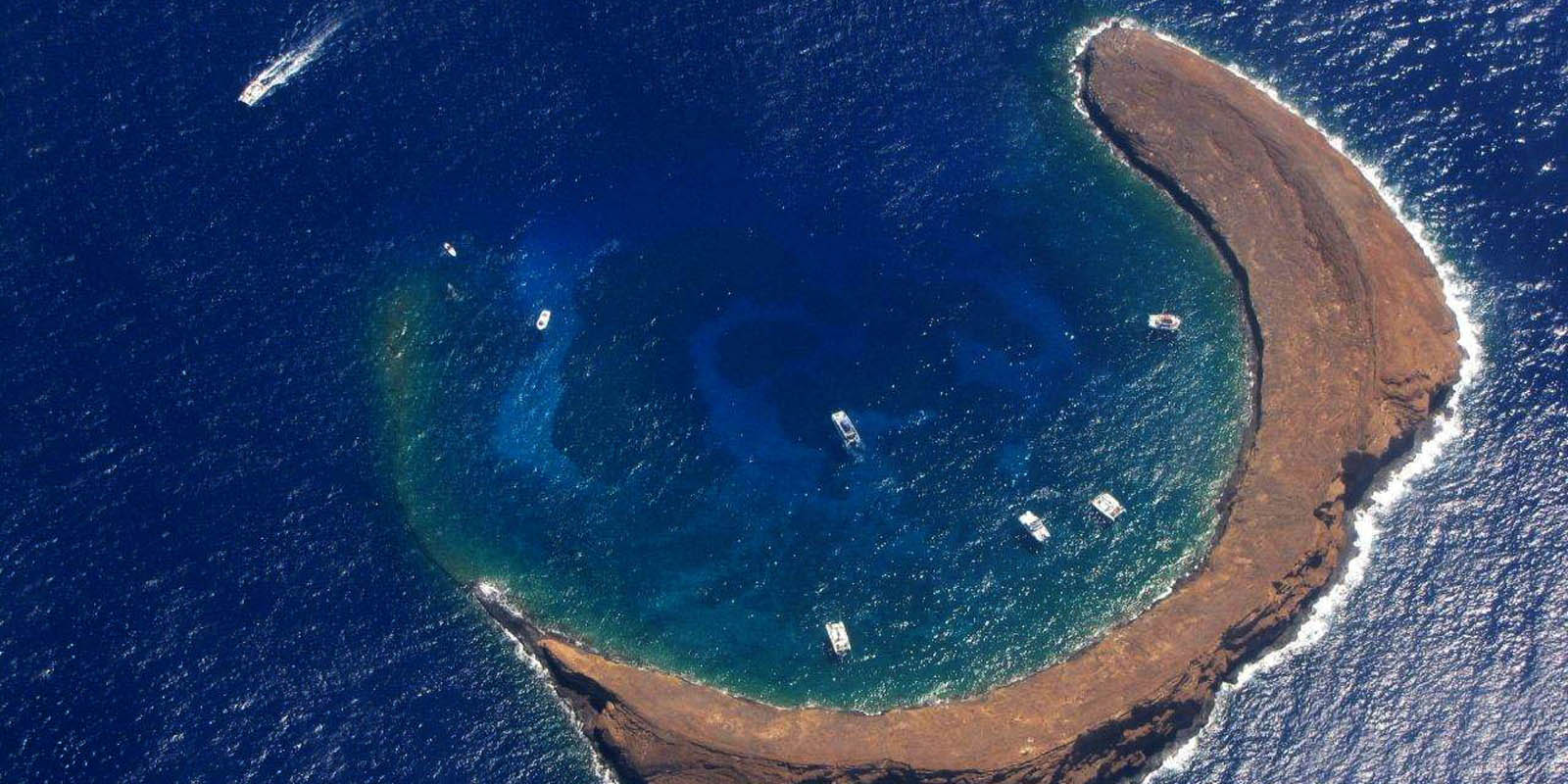Hawaiian Green Sea Turtles
Scientific name: Chelonia mydas
Hawaiian name: honu
Sea turtles are air-breathing reptiles that are well adapted for their life in the sea. Their body is streamlined to move easily through the water with little resistance. Their front flippers are used for swimming, pulling them through the water with powerful strokes, the back flippers act like rudders for steering. Like other reptiles, the sea turtle's skin is protected by tough scales, and like other turtles, fused bony plates form a protective shell (called the carapace on top, plastron on the bottom). There are seven species of sea turtles found in the world's warm oceans, and three of these have been reported from Hawaiian waters: the hawksbill, leatherback, and most common, the green sea turtle.
Green turtles are a long-lived, charismatic species that occur throughout the Hawaiian Archipelago. Six species of sea turtles occur in the Pacific, but only two sea turtle species, the green (honu) and Hawksbill (honu'ea), occur regularly in Hawaiian coastal waters. Sea turtles are part of the identity of the islands and hold a special place in the minds and hearts of the people of Hawaii. Nearly depleted during the 1960's, the green turtle population is on the road to recovery towards fulfilling their ecological role as part of the Hawaiian reef community. They are a true Hawaiian local, a genetically distinct stock that nests only in Hawaii.
Green sea turtles, once widespread throughout the Hawaiian Islands, are now recognized as a threatened species. Habitat destruction, human disturbance, and overharvesting of these slow-moving animals have led to a dramatic decline in their numbers. There is no current estimate of the overall Hawai`i population, instead the population is monitored by the number of nesting sea turtles at a particular site. Since protection, the number of nesting females has increased at approximately 5.7% per year, at French Frigate Shoals where 90% of the nesting in Hawaiian Islands occurs. French Frigate Shoals is in the remote Northwestern Hawaiian Islands and part of Papahānaumokuākea Marine National Monument. Many adult turtles live and feed around the main Hawaiian Islands, but make the migration of several hundred miles to the breeding grounds every two to four years.
Green turtles live in nearshore coastal habitats throughout Hawaii, with high fidelity (devotion) to specific reef, rock, bay, or lagoon feeding locations. Most of their time is spent at depths less than 100 feet but they can dive to depths of over 500 feet when migrating. During the breeding season males and females swim 500-800 miles from their feeding grounds in the main Hawaiian Islands to their nesting beaches, primarily at FrenchFrigate Shoals, in the Northwestern Hawaiian Islands. This journey takes approximately 30 days. The average swimming speed of a green turtle is about one mile per hour during migration; however, they have been known to reach speeds of 20 miles per hour in short bursts when fleeing a potential predator.
One reason why they may bask on the shore is to conserve energy and regulate their body temperature. Green turtles are reptiles, so they do not maintain a constant core body temperature; instead their body temperature is influenced by the temperature of their environment. Green turtles are known to bask only in the Galapagos Islands, Australia and Hawaii. Basking turtles provide excellent wildlife viewing opportunities. However, please give basking turtles space. Never try to push a sea turtle back into the ocean or pour water on it. Allow them a clear path and never block their access to land or sea.
It is impossible to tell juvenile female and male sea turtles apart by external observation. Once they are adults, males are distinguished from females by their significantly longer and thicker tails. Mature males also have a pronounced claw on each of their four flippers used to hold onto females during mating. The incubation temperature of a nest determines whether a sea turtle will be a male or female. Generally, higher nest temperatures produce more females and cooler temperatures yield more males.
Nesting
Green turtles are a long-lived, charismatic species that occur throughout the Hawaiian Archipelago. The following nesting information answers some of the most commonly asked questions about green turtles in Hawaii. Green turtles worldwide lay their eggs on tropical and subtropical beaches. Like all species of sea turtles, green turtles return to the nesting area where they were hatched to reproduce when they reach adulthood (maturity). In Hawaii, over 90% of green turtle nesting takes place at French Frigate Shoals in the Northwestern Hawaiian Islands. Limited nesting also occurs on other islands and atolls of the Northwestern Hawaiian Islands and in low, but increasing, numbers at some locations in the main Hawaiian Islands. One clutch (nest of eggs) laid by a Hawaiian green turtle may contain 60 to 120 eggs, with an average of 100 eggs. Incubation takes approximately 60 days and hatchlings emerge from their nest at night. On average, a female turtle will lay three to five nests in a season and each nest is laid approximately two weeks apart. She will migrate to nest every two to five years. We don't we see small, baby turtles in Hawaii, because once hatchlings (baby turtles) enter the ocean, they embark upon an oceanic offshore journey called the 'lost years' that can last up to a decade. No one knows exactly where they go or how they survive during this time. Eventually they return to Hawaii's nearshore reef habitats as small juveniles, about 14 inches (35 cm) in shell length. From that point forward they live, feed, grow, mature and migrate within the Hawaiian Archipelago for the remainder of their life. After mating at sea, female green turtles crawl ashore at night, dig a hole in the sandy beach, and lay about 100 leathery eggs (each about 2 inches/5 cm across). Each female may lay up to six clutches of eggs each breeding season. The young turtles hatch as a group after about two months, climb from their nest and rush to the sea. Young turtles are rarely seen during their first years of life, presumably they drift with the currents out on the open ocean, feeding on small animals that live close to the surface. When the turtles reach approximately 1½ to 2 feet (to 61 cm) in length (about 15 pounds/6.75 kg), their diet changes and they move into shallower water where they can graze on seaweeds. The life span of the green sea turtle is still unknown, but it appears that Hawaiian turtles grow very slowly and may be 20 to 35 years of age before they are sexually mature. Once mature, males can be distinguished by their longer, thicker tails and females by their higher, more domed shells. Adult turtles can reach shell lengths of 4 feet (1.2 m) and weight up to 400 pounds (180 kg). During the day, green turtles swim and feed on the reef, surfacing to breathe at roughly 15 minute intervals. Green sea turtles in most parts of the world only leave the ocean to lay their eggs on sandy beaches. In Hawaii, both females and males may crawl ashore to bask in the sun. This behavior may help them warm up their bodies and may protect them from their main predator, the tiger shark. At night, turtles are often found underwater, resting on the bottom or under ledges. With slower night-time metabolism, they only have to surface once every few hours. This species was in a steep decline as of the 1970s because of direct harvest of both turtles and eggs by humans. The population has grown steadily over the last thirty years after protection began in 1978. Greens are the most common species of sea turtle found in Hawaiian waters. Despite an overall declining trend globally, green turtle population growth rates are variable among nesting populations and regions. The Hawaiian green turtle population is actually increasing in abundance and has increased 53% over the last 25 years. Hawaiian green sea turtles are unique in spending their entire lives within the Hawaiian Island chain. All other populations of green turtles engage in international migrations that make it more difficult to protect them. The Hawaiian and other populations within U.S. waters are protected by the federal Endangered Species Act that forbids the harassing, harming, or killing turtles.
Physical Description
Green turtles worldwide are the largest of the hard-shelled sea turtles. Adult green turtles in Hawaii are smaller than their Atlantic counterparts. Hawaiian green turtles grow to a shell (carapace) length of about 36 inches (90 cm) and weigh approximately 250 pounds; whereas Atlantic green turtles can measure up to 48 inches (120 cm) and weigh more than 400 pounds. Females typically grow larger than males. A typical adult green turtle has a carapace length of 40 inches and can weigh from 200-500 lbs. Green turtles exhibit counter-shading with a carapace (shell) that can range from olive brown to black in color and a much lighter yellow plastron (underside). Green turtles have five vertebral scutes running down the middle of their shell and four costal scutes on each side. (Unlike the hawksbill turtle which has the same number of scutes, the scutes of the green turtle do not overlap). Another distinguishing characteristic of this species is their two large prefrontal scales located between the eyes. Green turtles, like all sea turtles, grow very slowly. Different populations of turtles grow at different rates based on habitat quality, availability and abundance of food sources, and environmental conditions. A typical, healthy green turtle in Hawaii will grow only half an inch (1-2 cm) per year until they reach maturity. It likely takes between 25-40 years for a Hawaiian green turtle to reach maturity and reproduce for the first time.
Diet
Green turtles are primarily herbivores (vegetarians). They feed on sea grasses and algae (green and red) that grow on rocks and reefs in the nearshore environment. Of approximately 400 species of algae present in Hawaii, only a small portion account for the majority of what they eat. Sea turtles do not need a helping hand from humans. Please remember that feeding or attempting to interact with sea turtles can habituate them to humans, cause stress and adversely alter their behavior and long-term survival. Keep wild turtles wild; please enjoy from a distance and avoid the temptation to feed them. Adults primarily eat algae. Over 275 different species of seaweed have been found in the stomachs of Hawaiian green turtles. In order to deal with this diet of roughage, green turtles have microflora living in their large intestine that help breakdown the cellulose that is otherwise undigestible. Other food items they consume in lesser amounts include jellyfish, salps, mollusks, sponges, and tubeworms. East Pacific green turtles tend to eat more animal prey than other populations. On the outside, green turtles are usually some combination of brown, black and grey in color, with yellow accents. They are called "green" turtles because their internal fat tissue is green due to their herbivorous diet.
Lifespan
The lifespan for sea turtles in generally unknown but for green turtles is thought to be around 60-70 years.
Reproduction
Green turtles become sexually mature at 25-35 years, and some may be as old as 40 before being able to reproduce. The length of reproductivity has been estimated to range from 17 to 23 years. They return to nesting beaches to lay eggs every two to three years and will deposit three to six clutches per nesting season with an average of twelve days in between. Each clutch consists of about 100 eggs that will incubate for 60 days.
Distribution
More than 90% of the Hawaiian population of green turtles nests at French Frigate Shoals in the Northwestern Hawaiian Islands. They migrate to feed mainly in the coastal areas of the Main Hawaiian Islands. Limited nesting locations and important coastal foraging areas for green turtles are found throughout the Pacific islands.
Local Cultural Significance
Historically, green turtles have played a large role in Polynesian and Micronesian cultures. In addition to being used as a food source, native peoples all over the Pacific utilized all parts of the turtle making tools and jewelry out of the bones, and containers and utensils out of the carapace. Turtle fat was sometimes used for medicinal purposes to treat burns and other skin disorders. Turtles were often considered the property of the tribal chief and their utilization was regulated by some form of island council.
In the Hawaiian Islands, there were families that considered the green turtle a personal family deity or aumakua, not to be eaten or harmed. One legendary example is the story from the Big Island of Hawaii of the turtle named Kauila. She was believed to be able to change at will into human form to watch over the village children playing near the shore. Artistic elements of green turtles have also been featured prominently in some cultures of the region, such as petroglyphs and tattoo designs.Potential Threats
Disease - Disease is considered the primary threat to green turtles in Hawaii. Fibropapillomatosis causes tumor growth on the exposed soft tissue including flippers, head, and neck areas. While the tumors do not appear to be accompanied by any other symptoms or negative effects, their location could be detrimental to the survival of an individual. For example, if a tumor obstructs a turtle's mouth or eyes enough, it may starve due to inability to locate and/or ingest food. Tumors around the eyes may also impair vision so that a turtle's ability to avoid predators is reduced.
Harvest - In a American Samoa, Guam and the Commonwealth of the Marianas Islands, direct harvest remains a serious threat to green turtle populations. Hawaiian green turtles have been sucessfully protected from these threats for over 25 years and their population growth is evidence of the success of such protection.
No one knows for sure but some Hawaiian green turtles have been documented nesting for more than 30 years, so that means they are at least 60-70 years old. In Hawaii, threats to their long-term survival include: habitat deterioration (from coastal development), nearshore recreational fishery interactions, boat strikes, ingestion of and entanglement in discarded fishing line, disease, illegal harvest and climate change.
Hawaiian green turtles have predators throughout all stages of life. Nests or eggs in the Northwestern Hawaiian Islands are at low risk of predation, but eggs deposited on beaches in the main Hawaiian Islands may be consumed by mongooses, rats, feral dogs and cats, pigs, ghost crabs, ants, plants, bacteria, or fungus. Once the green turtle hatchlings emerge from their nest and crawl toward the sea, they must dodge crabs, feral animals and sea birds on the beach. In the water, hatchlings and small juvenile sea turtles face fish, sharks and other marine predators. The tiger shark is the major natural predator for large juvenile and adult Hawaiian green turtles. Although illegal, sea turtles in Hawaii are still harvested to some degree; therefore, humans can also be considered predators of turtles.
Viewing Guidelines
If you see sea turtles out basking on the beach or in the water while snorkeling, admire them from a reasonable distance and do not alter their natural behavior. Please do not attempt to touch, feed or harass sea turtles.





